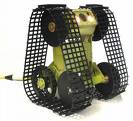Situation Awareness for Variable Geometry Robots
Polymorphic robots are capable of operating in dynamic environments. They can change shape to maximize their effectiveness. However, their shape-shifting ability adds complexity to SA when designing an intuitive user interface. The VGTV travels through snow and rough terrain without problems. Its sealed water-tight chassis allows it to work in difficult environments such as desert sand and ocean floors.
The VGTV was designed to be polymorphic; the robot’s physical configurations range from laying completely flat to raised upright. Our VGTV was used in experiments conducted in conjunction with MITRE and American Standard Robotics. The experiments tested the impact of pose information on user performance and SA.
The presence of pose information was found to increase SA. When the user was presented with robot pose information, we found a significant decrease in the number of times the robot tipped over or its forward motion was hindered. Without the pose display, participants were also likely to use the upright raised pose to reorient, thus requiring additional manipulation time.














